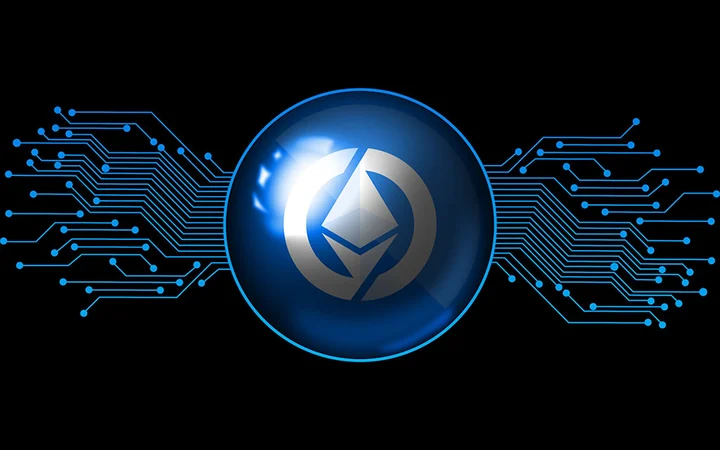Deconstructing the equation What does the wealth password on Perp DEX look like?
Unpacking the Unknown Deciphering the Wealth Code on the Perp DEX PlatformEquation went live for a month and its TVL tripled, with trading volume reaching $500m. It can be said that Equation is a success, as it excels in product design, token economics, and user experience. It is worth learning from for other startup projects.

Therefore, this article will deconstruct Equation and show readers what the “wealth code” looks like on Perp DEX.
Introduction
In spot trading, the trading volume of Dex has already gained a certain percentage compared to Cex. Users are also becoming more familiar with the use of Dex such as Uniswap and Curve. However, in the aspect of perpetual contract trading, the on-chain trading volume still has a huge gap compared to centralized exchanges. According to The Block’s data, the on-chain contract trading volume only accounts for about 1.5% of centralized exchanges, so there is still significant room for development for on-chain perpetual contract trading platforms. Currently, there are various on-chain perpetual contract exchanges such as gmx, gains network, dydx, hyperliquid, etc., each implementing perpetual trading in various ways.
- Exploring the Real Differences Between ETH and Solana.
- No Safe Wallet Hacker Swipes Over $2 Million- What the Blockchain?!
- Mantle Unleashes the Power of Non-Custodial Liquid Staking Protocol on Ethereum
The recently launched Equation has developed rapidly and attracted a large number of users through innovative product mechanisms and transaction mining. Its Total Locked Value (TVL) has reached 16 million.

Product Mechanism
About Perpetual Contracts
The difference between perpetual contracts and traditional futures is that there is no expiration date for perpetual contracts. Traditional futures have specific settlement dates. Traders can hold open positions of perpetual contracts indefinitely and close them at any time. There are weekly, bi-weekly, quarterly, and quarterly futures contracts.
The term of perpetual contracts is specified in hours (specific time depends on the specific exchange). When the n-period expires, the exchange automatically “rolls” (transfers/expands) the positions of the actual perpetual contracts to the next contract.
The lack of expiration is why perpetual futures are popular. It is a flexible tool that is often traded on most cryptocurrency exchanges with high leverage. Trading perpetual futures has the potential for higher profits compared to spot trading. But the risks are also higher. Trading perpetual futures utilizes the funding rate mechanism.
The funding rate is a small amount of money paid by one party of the contract to the other party. It is meant to ensure periodic convergence between the futures price and the index price (the price of the underlying asset). It does not apply to exchange commissions. The funding rate is determined by the market and varies depending on the market conditions. Typically, in a bull market, long traders pay rewards to long and short traders. In bear markets, the situation is the opposite.
Equation Design
Trading Mechanism: Different trading pools are set up for different trading pairs as counterparties for traders. When users open positions, close positions, or forced liquidations, LPs always passively take the opposite positions to users with the same scale, same price, but opposite direction.
Pricing Method: The price of perpetual contracts is determined by the liquidity pool using an innovative BRMM pricing method. BR is the balance rate of the liquidity pool, calculated as BR = value of short positions held by LP / total liquidity of LP. If LP has no position, then BR is zero, indicating that the liquidity pool is in a completely balanced state. When LP holds long positions, BR becomes negative.
The perpetual contract premium rate (PR) is the premium rate of the perpetual contract liquidity pool price (P) relative to the index price (Pi). PR = f(BR), where PR is a function of BR. This function is determined by the current state of the liquidity pool and system parameters. Specifically, when BR = 0, f(BR) = 0, which means that the premium rate is zero when LP is in a completely balanced state. That is,

When users open or close positions, it causes changes in LP holdings, which in turn affects the BR value. Then this formula can be used to calculate the contract price changes caused by changes in user positions.
Funding rate: In the BRMM model, when LP holds short positions, long position holders compensate short position holders; and when LP holds long positions, short position holders compensate long position holders. Conversely, when limited partners hold long positions, short position holders compensate long position holders.

Where:
-
IR (Interest Rate) can be adjusted by DAO
-
PR (Premium Rate) calculated every five seconds APR (Average Premium Rate) = (1*PR_1 + 2*PR_2 + 3*PR_3 + … + n*PR_n) / (1+2+3+…+n)
User Experience
On the trading side, equation provides lower maintenance margins and higher leverage compared to dydx and gmx. Cryptocurrency users themselves are more inclined to take risks, so higher leverage tools will be more popular among users.

A risk-buffering fund (RBF) is designed on the LP side: When LP incurs losses as the temporary counterparty of users, it must first bear all temporary losses of LP until the fund balance is depleted. The existence of RBF significantly reduces the possibility of LP being affected by temporary losses. With the expansion of RBF’s scale, LP may use higher leverage without easily facing liquidation risks. The income of RBF comes from three sources:
-
Partial transaction fees paid by traders when opening, closing, and force closing positions.
-
Profits generated by LP as the temporary counterparty of traders.
-
When LP is liquidated, its funds will be directly transferred to RBF.
Token Design
Equation’s token design includes FT and NFT, and incentivizes user participation through a 100% fair distribution model.
-
EQU: As the native token, EQU is generated 100% through PoS mining, liquidity mining, and referral mining. It is subject to a 90-day lock-up period after mining, and there are penalties for early withdrawal. In addition, the ve model is adopted to empower the token, where users can lock EQU-ETH Pool LP to acquire veEQU, which entitles them to 25% of the protocol’s transaction fees.

-
EFC: It is divided into different levels, including Member, Connector, and Architect.
-
Member: There are a total of 10,000 members, distributed to individuals who actively promote Equation. Each NFT can generate multiple referral codes, and holders can earn 10% of the referee’s transaction fees and mining rewards. Additionally, referees can enjoy a 10% fee discount and a 1.1x liquidity mining multiplier. Once an NFT is transferred, the referral code will also be transferred, and the original holder will no longer receive any benefits.
-
Connector: There are a total of 100 connectors, distributed to Equation’s core promotion team. Each Connector NFT can mint 100 Member NFTs and earn 10% of the total revenue generated by these minted NFTs.
-
Architect: There are a total of 100 architects, allocated to Equation’s core development team. Architect NFTs are entitled to 25% of the transaction fee income.
We will continue to update Blocking; if you have any questions or suggestions, please contact us!
Was this article helpful?
93 out of 132 found this helpful
Related articles
- DEX Markets Ready to Launch BabyGROK Token: Prepare for Liftoff!
- Metis Research Report | The First Decentralized Sorter of Layer 2
- Swinging to Success Chimpzee (CHMPZ) Soars over $2.4 Million as Eco-Friendly Token Leaves Investors Hungry for More
- Arbitrum DAO: Strengthening the Foundation of the Digital Asset Universe
- OpenAI Trapped in Distantly Leading
- US Space Force BTC is a Network Revolution
- UK legislators are cautious about introducing retail CBDCs due to privacy and financial stability concerns.





